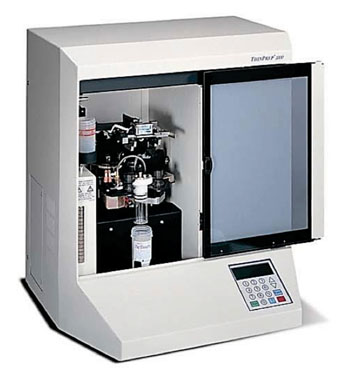Human Papilloma Virus Tests Compared and Evaluated
By LabMedica International staff writers
Posted on 29 Nov 2016
High-risk human papillomavirus testing is already part of cervical cancer screening programs in a number of countries and new tests need to be validated not only in clinical studies but also in routine screening settings with regard to their clinical performance.Posted on 29 Nov 2016
As persistent infection with High-Risk Human Papillomaviruses (HR HPV) is a necessary risk factor for the development of (pre)-cancer, numerous HPV tests are nowadays commercially available to be used in cervical cancer screening programs. However, only a small number of these tests have been approved by the authorities.

Image: The ThinPrep 2000 processor, an automated slide preparation system for use with the ThinPrep Pap test (Photo courtesy of Hologic).
Scientists at the University Hospital Tübingen (Germany) and their colleagues evaluated in a random sample of 1,456 patients from a German routine screening population of 13,372 women equal to or older than 30 years of age screened primarily by liquid-based cytology (LBC) that was complemented by 48 CIN3+ cases. Clinical sensitivities, relative specificities and positive predictive values (PPV) for both HPV tests were determined based on histologically confirmed high-grade cervical disease (CIN3+) as clinical outcome.
LBC was performed by the ThinPrep 2000 Processor (Hologic, Bedford, MA, USA) and cytology results were reported using the Munich Nomenclature II and were translated into The Bethesda System (TBS) LBC results were considered negative when the result was Pap I/II (Normal) or Pap IIw (ASC-US); all other results were considered positive. LBC samples were tested by Abbott RealTime High Risk HPV Test (RT hrHPV, Abbott Laboratories, Abbott Park, IL, USA). HPV genotyping was carried out using the INNO-LiPA HPV Genotyping Extra test (Fujirebio, Ghent, Belgium), which identifies 20 HPV genotypes.
The investigators found that HR HPV prevalence in residual LBC samples was found to be 5.4% by the RT hrHPV test and 5.6 % by the HR HC2 test, respectively. There was a high overall agreement between the RT hrHPV test and the HC2 assay for detection of HR HPV. Relative sensitivities for detection of CIN3+ in patients with abnormal cytology was 93.8 % for the RT hrHPV assay and 97.9 % for HC2. Relative specificities and PPVs were comparable for both tests. The highest PPV was calculated for the specific detection of HPV16 by the RT hrHPV test (84.2 %). The RT hrHPV test showed a reduced sensitivity for detection of HVP31-positive CIN3 +.
The authors concluded that that the sensitivities and relative specificities of the RT hrHPV and the HR HC2 test are comparable. However, it appears that the RT hrHPV test has a reduced sensitivity for the detection of HPV type 31, which in this study has led to two CIN3+ cases missed by the RT hrHPV test. A considerable benefit of the RT hrHPV HPV test is its separate type specific detection of the most prevalent HPV genotypes 16 and 18, which together account for a total of an estimated 70.4 % of cervical cancer cases worldwide. The study was published on November 11, 2016, in the journal BMC Infectious Diseases.
Related Links:
University Hospital Tübingen
Hologic
Abbott Laboratories
Fujirebio







 Analyzer.jpg)






